A Retrieval of Glyoxal from OMI over China: Investigation of the Effects of Tropospheric NO2
Abstract
:1. Introduction
2. Satellite Instrument and Method
2.1. OMI
2.2. SCIAMACHY
3. Glyoxal Retrievals
3.1. Slant Columns
3.2. Air Mass Factor Computation
4. Results
4.1. The OMI-CAS Glyoxal Retrieval
4.2. Intercomparison with Other Datasets
5. Discussion
6. Conclusions
Supplementary Materials
Author Contributions
Funding
Acknowledgments
Conflicts of Interest
References
- Strong, J.; Whyatt, J.D.; Metcalfe, S.E.; Derwent, R.G.; Hewitt, C.N. Investigating the impacts of anthropogenic and biogenic VOC emissions and elevated temperatures during the 2003 ozone episode in the UK. Atmos. Environ. 2013, 74, 393–401. [Google Scholar] [CrossRef]
- Sillman, S. The relation between ozone, NOx and hydrocarbons in urban and polluted rural environments. Atmos. Environ. 1999, 33, 1821–1845. [Google Scholar] [CrossRef]
- Li, Y.; Lau, A.K.H.; Fung, J.C.H.; Zheng, J.Y.; Liu, S.C. Importance of NOx control for peak ozone reduction in the Pearl River Delta region. J. Geophys. Res. Atmos. 2013, 118, 9428–9443. [Google Scholar] [CrossRef]
- Han, D.M.; Wang, Z.; Cheng, J.P.; Wang, Q.; Chen, X.J.; Wang, H.L. Volatile organic compounds (VOCs) during non-haze and haze days in Shanghai: characterization and secondary organic aerosol (SOA) formation. Environ. Sci. Pollut. Res. 2017, 24, 18619–18629. [Google Scholar] [CrossRef] [PubMed]
- Wei, W.; Li, Y.; Wang, Y.; Cheng, S.; Wang, L. Characteristics of VOCs during haze and non-haze days in Beijing, China: Concentration, chemical degradation and regional transport impact. Atmos. Environ. 2018, 194, 134–145. [Google Scholar] [CrossRef]
- Alvarado, L.M.A.; Richter, A.; Vrekoussis, M.; Wittrock, F.; Hilboll, A.; Schreier, S.F.; Burrows, J.P. An improved glyoxal retrieval from OMI measurements. Atmos. Meas. Tech. 2014, 7, 5559–5599. [Google Scholar] [CrossRef]
- Zhao, Y.; Mao, P.; Zhou, Y.D.; Yang, Y.; Zhang, J.; Wang, S.K.; Dong, Y.P.; Xie, F.J.; Yu, Y.Y.; Li, W.Q. Improved provincial emission inventory and speciation profiles of anthropogenic non-methane volatile organic compounds: a case study for Jiangsu, China. Atmos. Chem. Phys. 2017, 17, 7733–7756. [Google Scholar] [CrossRef] [Green Version]
- Wei, W.; Wang, S.X.; Chatani, S.; Klimont, Z.; Cofala, J.; Hao, J.M. Emission and speciation of non-methane volatile organic compounds from anthropogenic sources in China. Atmos. Environ. 2008, 42, 4976–4988. [Google Scholar] [CrossRef]
- Fu, T.M.; Jacob, D.J.; Wittrock, F.; Burrows, J.P.; Vrekoussis, M.; Henze, D.K. Global budgets of atmospheric glyoxal and methylglyoxal, and implications for formation of secondary organic aerosols. J. Geophys. Res. Atmos. 2008, 113. [Google Scholar] [CrossRef] [Green Version]
- Miller, C.C.; Jacob, D.J.; Abad, G.G.; Chance, K. Hotspot of glyoxal over the Pearl River delta seen from the OMI satellite instrument: implications for emissions of aromatic hydrocarbons. Atmos. Chem. Phys. 2016, 16, 4631–4639. [Google Scholar] [CrossRef] [Green Version]
- Volkamer, R.; Molina, L.T.; Molina, M.J.; Shirley, T.; Brune, W.H. DOAS measurement of glyoxal as an indicator for fast VOC chemistry in urban air. Geophys. Res. Lett. 2005, 32, 93–114. [Google Scholar] [CrossRef]
- Volkamer, R.; Platt, U.; Wirtz, K. Primary and secondary glyoxal formation from aromatics: Experimental evidence for the bicycloalkyl-radical pathway from benzene, toluene, and p-xylene. J. Phys. Chem. A 2001, 105, 7865–7874. [Google Scholar] [CrossRef]
- Volkamer, R.; Spietz, P.; Burrows, J.; Platt, U. High-resolution absorption cross-section of glyoxal in the UV–vis and IR spectral ranges. J. Photochem. Photobiol. A Chem. 2005, 172, 35–46. [Google Scholar] [CrossRef]
- Wittrock, F.; Richter, A.; Oetjen, H.; Burrows, J.P.; Kanakidou, M.; Myriokefalitakis, S.; Volkamer, R.; Beirle, S.; Platt, U.; Wagner, T. Simultaneous global observations of glyoxal and formaldehyde from space. Geophys. Res. Lett. 2006, 33. [Google Scholar] [CrossRef] [Green Version]
- Vrekoussis, M.; Wittrock, F.; Richter, A.; Burrows, J. GOME-2 observations of oxygenated VOCs: what can we learn from the ratio glyoxal to formaldehyde on a global scale? Atmos. Chem. Phys. 2010, 10, 10145–10160. [Google Scholar] [CrossRef] [Green Version]
- Miller, C.C.; Abad, G.G.; Wang, H.; Liu, X.; Kurosu, T.; Jacob, D.J.; Chance, K. Glyoxal retrieval from the Ozone Monitoring Instrument. Atmos. Meas. Tech. 2014, 7, 3891–3907. [Google Scholar] [CrossRef] [Green Version]
- Liu, Z.; Wang, Y.H.; Vrekoussis, M.; Richter, A.; Wittrock, F.; Burrows, J.P.; Shao, M.; Chang, C.C.; Liu, S.C.; Wang, H.L.; et al. Exploring the missing source of glyoxal (CHOCHO) over China. Geophys. Res. Lett. 2012, 39. [Google Scholar] [CrossRef] [Green Version]
- Cao, H.; Fu, T.M.; Zhang, L.; Henze, D.K.; Miller, C.C.; Lerot, C.; Abad, G.G.; De Smedt, I.; Zhang, Q.; van Roozendael, M.; et al. Adjoint inversion of Chinese non-methane volatile organic compound emissions using space-based observations of formaldehyde and glyoxal. Atmos. Chem. Phys. 2018, 18, 15017–15046. [Google Scholar] [CrossRef]
- Stavrakou, T.; Muller, J.F.; De Smedt, I.; Van Roozendael, M.; Kanakidou, M.; Vrekoussis, M.; Wittrock, F.; Richter, A.; Burrows, J.P. The continental source of glyoxal estimated by the synergistic use of spaceborne measurements and inverse modelling. Atmos. Chem. Phys. 2009, 9, 8431–8446. [Google Scholar] [CrossRef] [Green Version]
- Stavrakou, T.; Muller, J.F.; Bauwens, M.; De Smedt, I.; Lerot, C.; Van Roozendael, M.; Coheur, P.F.; Clerbaux, C.; Boersma, K.F.; van der A, R.; et al. Substantial Underestimation of Post-Harvest Burning Emissions in the North China Plain Revealed by Multi-Species Space Observations. Sci. Rep. 2016, 6. [Google Scholar] [CrossRef]
- Lerot, C.; Stavrakou, T.; De Smedt, I.; Muller, J.F.; Van Roozendael, M. Glyoxal vertical columns from GOME-2 backscattered light measurements and comparisons with a global model. Atmos. Chem. Phys. 2010, 10, 12059–12072. [Google Scholar] [CrossRef] [Green Version]
- Jin, Y.; Andersson, H.; Zhang, S. Air Pollution Control Policies in China: A Retrospective and Prospects. Int. J. Environ. Res. Public Health 2016, 13, 1219. [Google Scholar] [CrossRef]
- Acarreta, J.R.; De Haan, J.F.; Stammes, P. Cloud pressure retrieval using the O2-O2 absorption band at 477 nm. J. Geophys. Res. Atmos. 2004, 109. [Google Scholar] [CrossRef]
- Kleipool, Q.L.; Dobber, M.R.; de Haan, J.F.; Levelt, P.F. Earth surface reflectance climatology from 3 years of OMI data. J. Geophys. Res. Atmos. 2008, 113. [Google Scholar] [CrossRef] [Green Version]
- Krotkov, N.A.; Lamsal, L.N.; Celarier, E.A.; Swartz, W.H.; Marchenko, S.V.; Bucsela, E.J.; Chan, K.L.; Wenig, M.; Zara, M. The version 3 OMI NO2 standard product. Atmos. Meas. Tech. 2017, 10, 3133–3149. [Google Scholar] [CrossRef]
- Marchenko, S.; Krotkov, N.A.; Lamsal, L.N.; Celarier, E.A.; Swartz, W.H.; Bucsela, E.J. Revising the slant column density retrieval of nitrogen dioxide observed by the Ozone Monitoring Instrument. J. Geophys. Res. -Atmos. 2015, 120, 5670–5692. [Google Scholar] [CrossRef] [PubMed] [Green Version]
- Irie, H.; Kanaya, Y.; Takashima, H.; Gleason, J.F.; Wang, Z.F. Characterization of OMI Tropospheric NO2 Measurements in East Asia Based on a Robust Validation Comparison. SOLA 2009, 5, 117–120. [Google Scholar] [CrossRef]
- Irie, H.; Kanaya, Y.; Akimoto, H.; Tanimoto, H.; Wang, Z.; Gleason, J.F.; Bucsela, E.J. Validation of OMI tropospheric NO2 column data using MAX-DOAS measurements deep inside the North China Plain in June 2006: Mount Tai Experiment 2006. Atmos. Chem. Phys. 2008, 8, 6577–6586. [Google Scholar] [CrossRef]
- Lamsal, L.N.; Krotkov, N.A.; Celarier, E.A.; Swartz, W.H.; Pickering, K.E.; Bucsela, E.J.; Gleason, J.F.; Martin, R.V.; Philip, S.; Irie, H.; et al. Evaluation of OMI operational standard NO2 column retrievals using in situ and surface-based NO2 observations. Atmos. Chem. Phys. 2014, 14, 11587–11609. [Google Scholar] [CrossRef]
- Chance, K.; Kurucz, R. An improved high-resolution solar reference spectrum for earth’s atmosphere measurements in the ultraviolet, visible, and near infrared. J. Quant. Spectrosc. Radiat. Transf. 2010, 111, 1289–1295. [Google Scholar] [CrossRef]
- Vandaele, A.C.; Hermans, C.; Simon, P.C.; Carleer, M.; Colin, R.; Fally, S.; Merienne, M.-F.; Jenouvrier, A.; Coquart, B. Measurements of the NO2 absorption cross-section from 42000 cm−1 to 10000 cm−1 (238–1000 nm) at 220 K and 294 K. J. Quant. Spectrosc. Radiat. Transf. 1998, 59, 171–184. [Google Scholar] [CrossRef]
- Malicet, J.; Daumont, D.; Charbonnier, J.; Parisse, C.; Chakir, A.; Brion, J. Ozone UV spectroscopy. II. Absorption cross-sections and temperature dependence. J. Atmos. Chem. 1995, 21, 263–273. [Google Scholar] [CrossRef]
- Gordon, I.E.; Rothman, L.S.; Hill, C.; Kochanov, R.V.; Tan, Y.; Bernath, P.F.; Birk, M.; Boudon, V.; Campargue, A.; Chance, K.V.; et al. The HITRAN2016 molecular spectroscopic database. J. Quant. Spectrosc. Radiat. Transf. 2017, 203, 3–69. [Google Scholar] [CrossRef]
- Rothman, L.S.; Gordon, I.E.; Babikov, Y.; Barbe, A.; Benner, D.C.; Bernath, P.F.; Birk, M.; Bizzocchi, L.; Boudon, V.; Brown, L.R.; et al. The HITRAN2012 molecular spectroscopic database. J. Quant. Spectrosc. Radiat. Transf. 2013, 130, 4–50. [Google Scholar] [CrossRef] [Green Version]
- Thalman, R.; Volkamer, R. Temperature dependent absorption cross-sections of O2–O2 collision pairs between 340 and 630 nm and at atmospherically relevant pressure. Phys. Chem. Chem. Phys. 2013, 15, 15371–15381. [Google Scholar] [CrossRef] [PubMed]
- Rozanov, A.; Rozanov, V.; Buchwitz, M.; Kokhanovsky, A.; Burrows, J.P. SCIATRAN 2.0 – A new radiative transfer model for geophysical applications in the 175–2400 nm spectral region. Advances in Space Research. 2005, 36, 1015–1019. [Google Scholar] [CrossRef]
- Rozanov, V.V.; Rozanov, A.V.; Kokhanovsky, A.A.; Burrows, J.P. Radiative transfer through terrestrial atmosphere and ocean: Software package SCIATRAN. J. Quant. Spectrosc. Radiat. Transf. 2014, 133, 13–71. [Google Scholar] [CrossRef]
- De Smedt, I.; Stavrakou, T.; Hendrick, F.; Danckaert, T.; Vlemmix, T.; Pinardi, G.; Theys, N.; Lerot, C.; Gielen, C.; Vigouroux, C. Diurnal, seasonal and long-term variations of global formaldehyde columns inferred from combined OMI and GOME-2 observations. Atmos. Chem. Phys. 2015, 15, 12241–12300. [Google Scholar] [CrossRef]
- De Smedt, I.; Theys, N.; Yu, H.; Danckaert, T.; Lerot, C.; Compernolle, S.; Van Roozendael, M.; Richter, A.; Hilboll, A.; Peters, E.; et al. Algorithm theoretical baseline for formaldehyde retrievals from S5P TROPOMI and from the QA4ECV project. Atmos. Meas. Tech. 2018, 11, 2395–2426. [Google Scholar] [CrossRef] [Green Version]
- Lin, J.T.; Martin, R.V.; Boersma, K.F.; Sneep, M.; Stammes, P.; Spurr, R.; Wang, P.; Van Roozendael, M.; Clémer, K.; Irie, H. Retrieving tropospheric nitrogen dioxide over China from the Ozone Monitoring Instrument: effects of aerosols, surface reflectance anisotropy and vertical profile of nitrogen dioxide. Atmos. Chem. Phys. 2014, 14, 1441–1461. [Google Scholar] [CrossRef]
- Lin, J.T.; Liu, M.Y.; Xin, J.Y.; Boersma, K.F.; Spurr, R.; Martin, R.; Zhang, Q. Influence of aerosols and surface reflectance on satellite NO2 retrieval: seasonal and spatial characteristics and implications for NOx emission constraints. Atmos. Chem. Phys. 2015, 15, 12653–12714. [Google Scholar] [CrossRef]
- Lorente, A.; Boersma, K.F.; Yu, H.; Dorner, S.; Hilboll, A.; Richter, A.; Liu, M.Y.; Lamsal, L.N.; Barkley, M.; De Smedt, I.; et al. alculation for NO2 and HCHO satellite retrievals. Atmos. Meas. Tech. 2017, 10, 759–782. [Google Scholar] [CrossRef]
- Bogumil, K.; Orphal, J.; Homann, T.; Voigt, S.; Spietz, P.; Fleischmann, O.C.; Vogel, A.; Hartmann, M.; Kromminga, H.; Bovensmann, H. Measurements of molecular absorption spectra with the SCIAMACHY pre-flight model: instrument characterization and reference data for atmospheric remote-sensing in the 230–2380 nm region. J. Photochem. Photobiol. A Chem. 2003, 157, 167–184. [Google Scholar] [CrossRef]
- Vandaele, A.C.; Hermans, C.; Fally, S.; Carleer, M.; Mérienne, M.F.; Jenouvrier, A.; Coquart, B.; Colin, R. Absorption cross-sections of NO2: Simulation of temperature and pressure effects. J. Quant. Spectrosc. Radiat. Transf. 2003, 76, 373–391. [Google Scholar] [CrossRef]
- Chance, K.V.; Spurr, R.J. Ring effect studies: Rayleigh scattering, including molecular parameters for rotational Raman scattering, and the Fraunhofer spectrum. Appl Opt. 1997, 36, 5224–5230. [Google Scholar] [CrossRef]
- Wang, P.; Stammes, P.; van der A, R.; Pinardi, G.; van Roozendael, M. FRESCO+: An improved O2 A-band cloud retrieval algorithm for tropospheric trace gas retrievals. Atmos. Chem. Phys. 2008, 8, 6565–6576. [Google Scholar] [CrossRef]
- Theys, N.; De Smedt, I.; Yu, H.; Danckaert, T.; van Gent, J.; Hormann, C.; Wagner, T.; Hedelt, P.; Bauer, H.; Romahn, F.; et al. Sulfur dioxide retrievals from TROPOMI onboard Sentinel-5 Precursor: algorithm theoretical basis. Atmos. Meas. Tech. 2017, 10, 119–153. [Google Scholar] [CrossRef] [Green Version]
- Wang, Y.; Yu, C.; Tao, J.; Wang, Z.; Si, Y.; Cheng, L.; Wang, H.; Zhu, S.; Chen, L. Spatio-Temporal Characteristics of Tropospheric Ozone and Its Precursors in Guangxi, South China. Atmosphere. 2018, 9, 355. [Google Scholar] [CrossRef]
- Yang, W.Q.; Zhang, Y.L.; Wang, X.M.; Li, S.; Zhu, M.; Yu, Q.Q.; Li, G.H.; Huang, Z.H.; Zhang, H.N.; Wu, Z.F.; et al. Volatile organic compounds at a rural site in Beijing: influence of temporary emission control and wintertime heating. Atmos. Chem. Phys. 2018, 18, 12663–12682. [Google Scholar] [CrossRef]
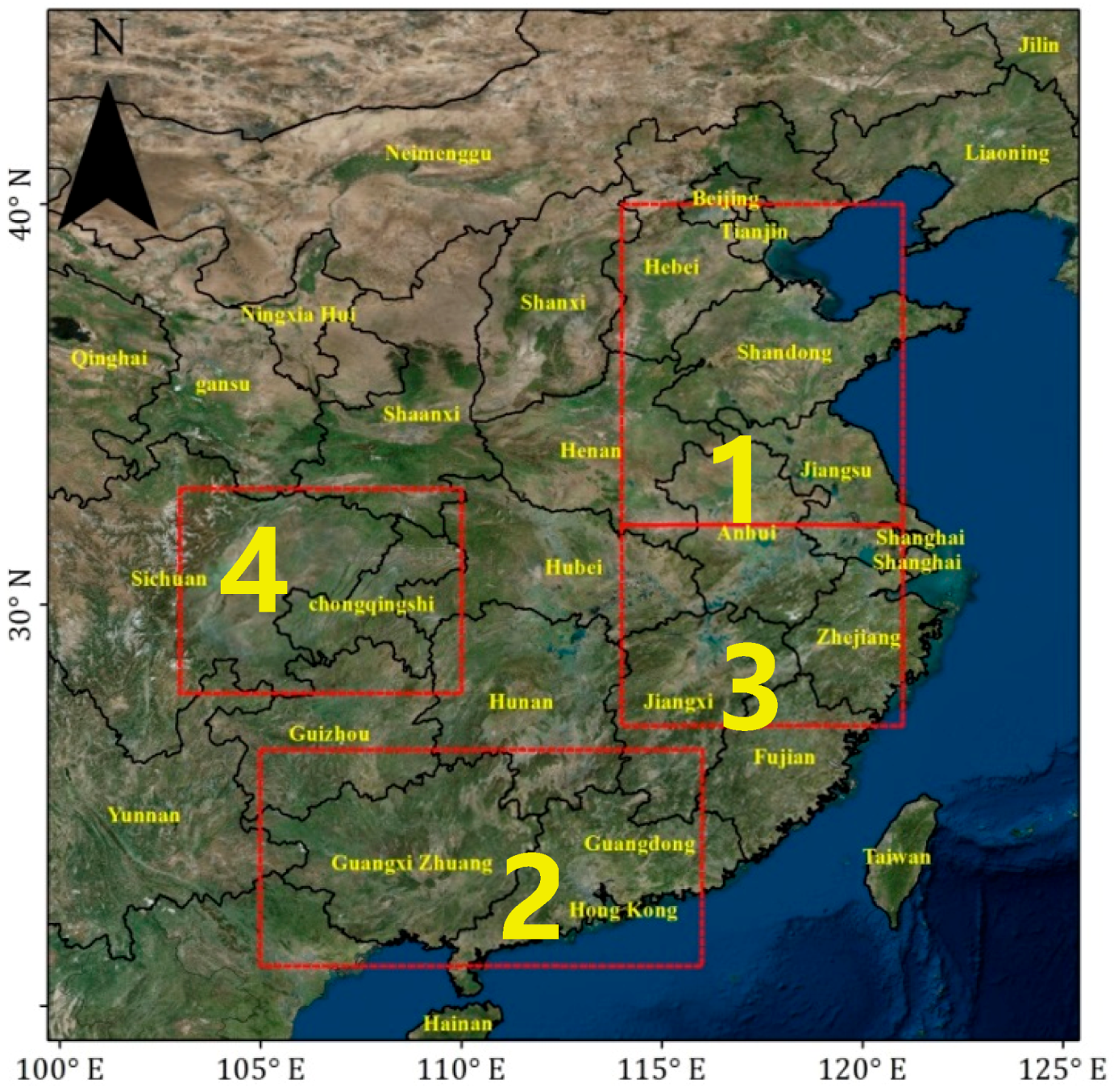
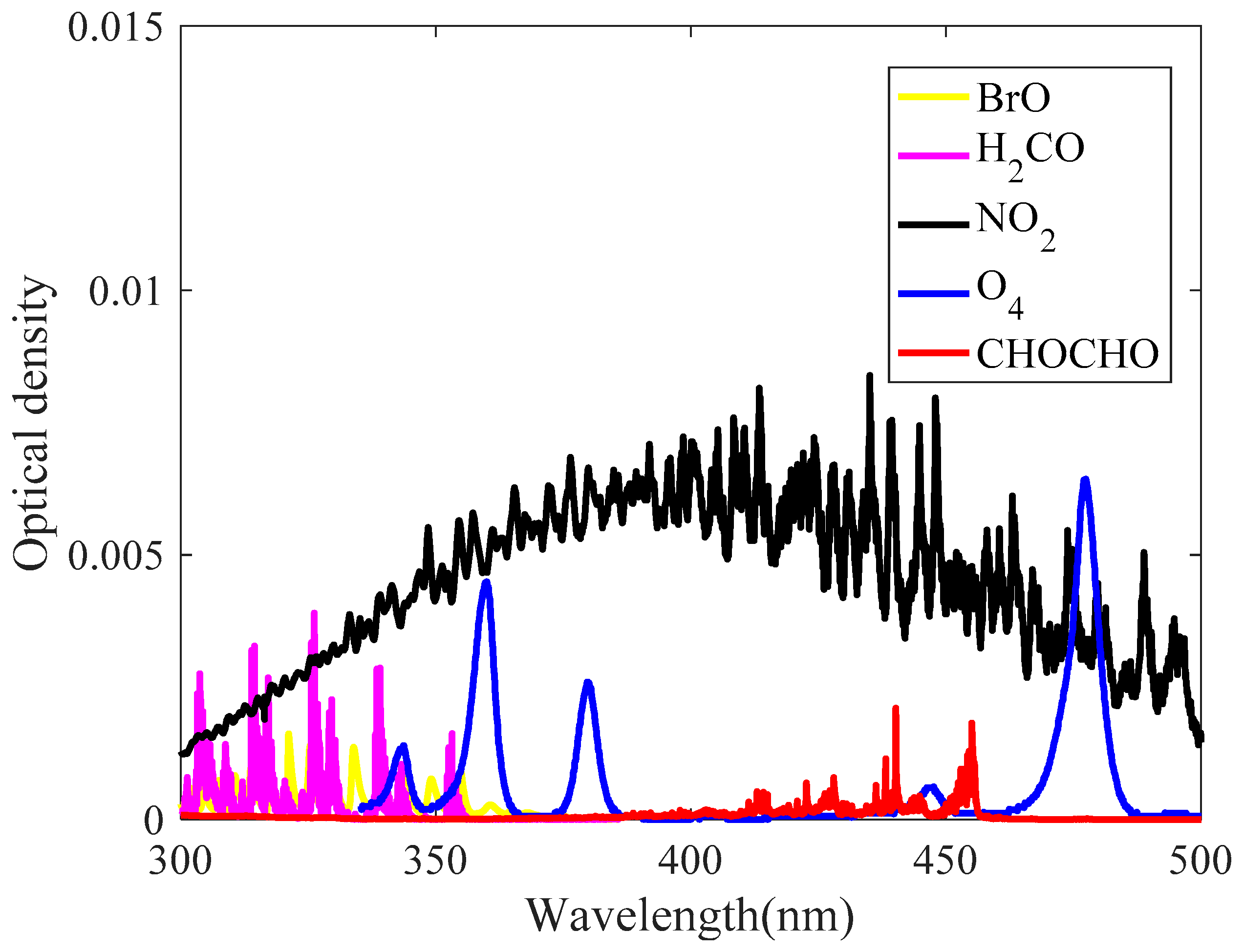
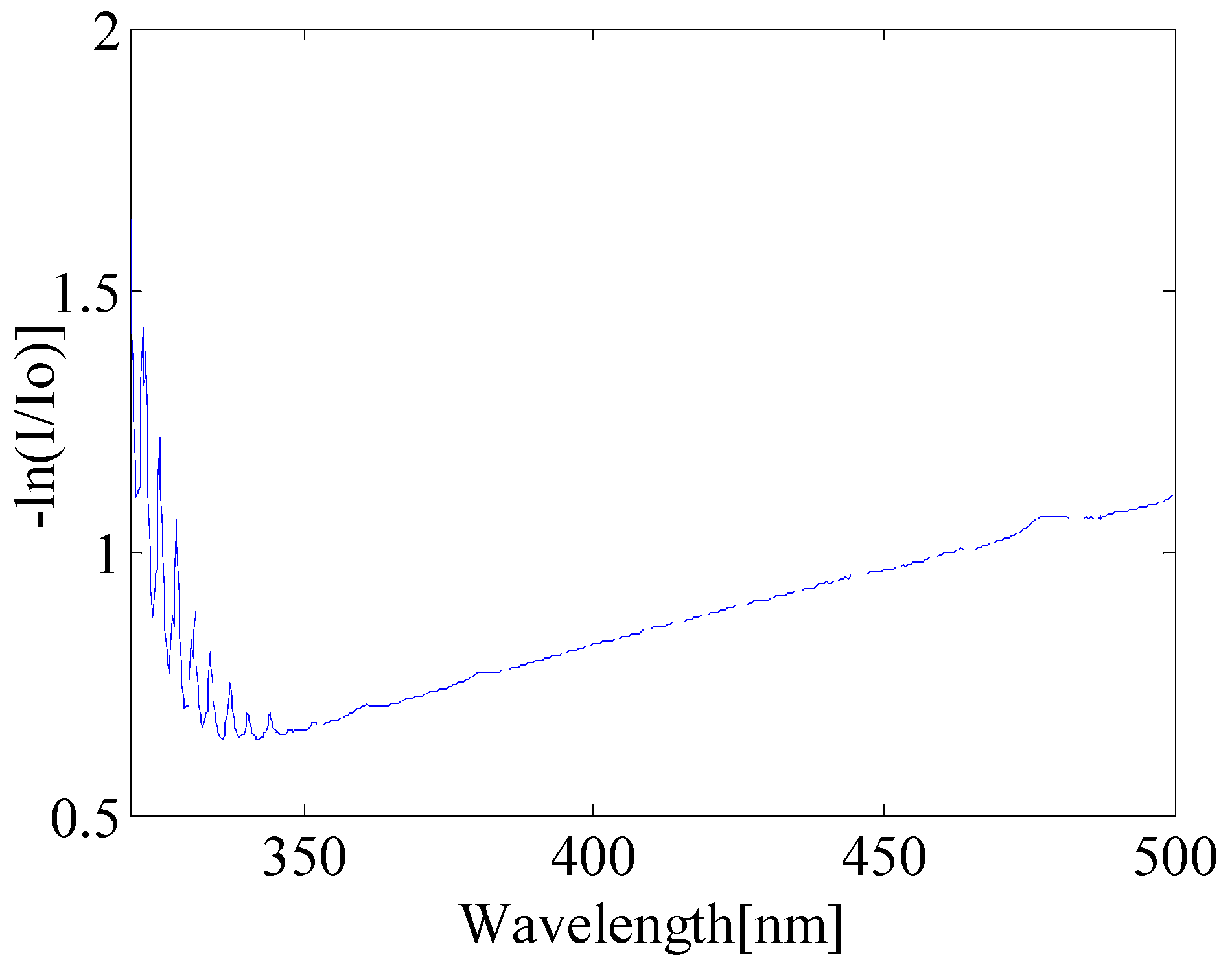

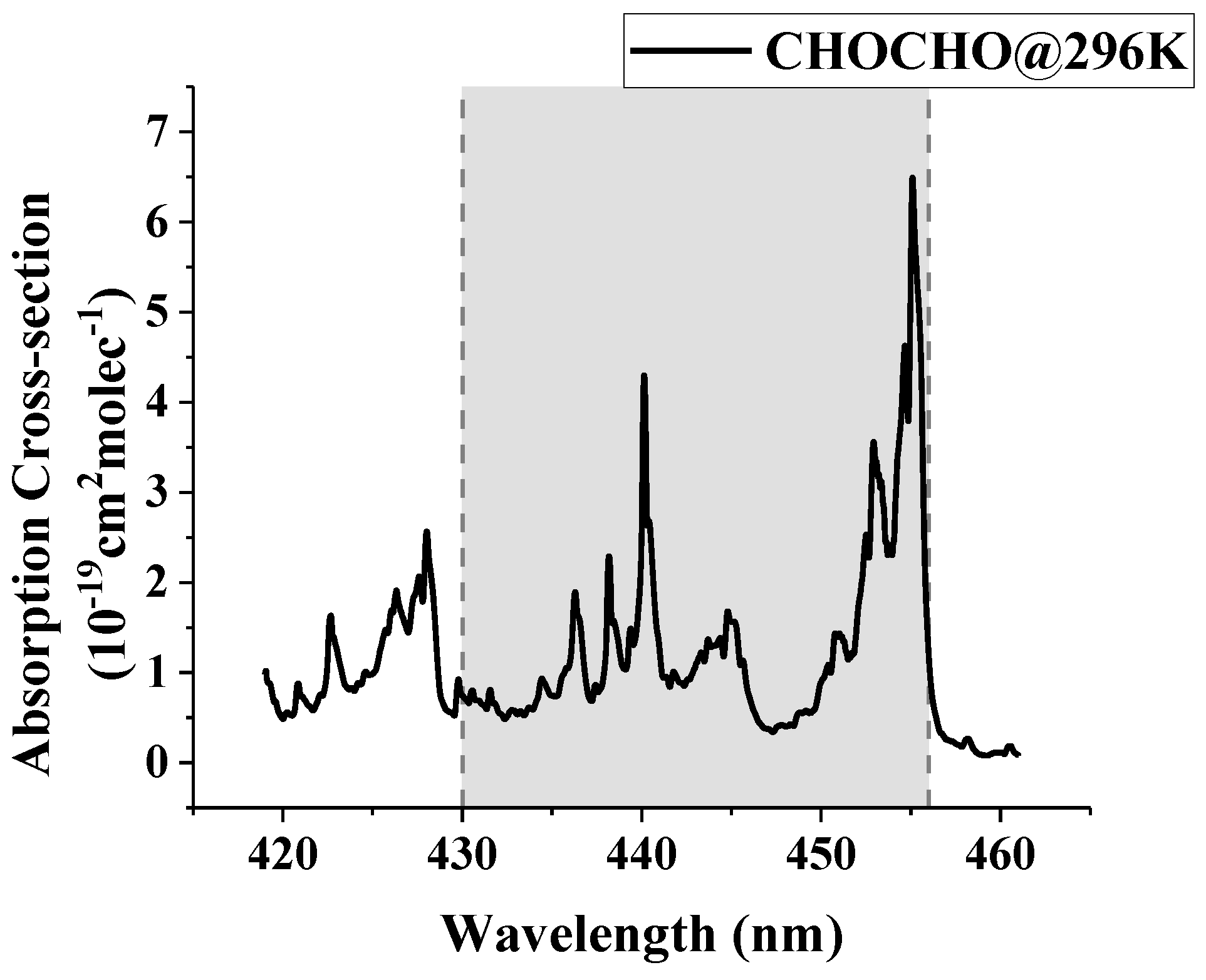

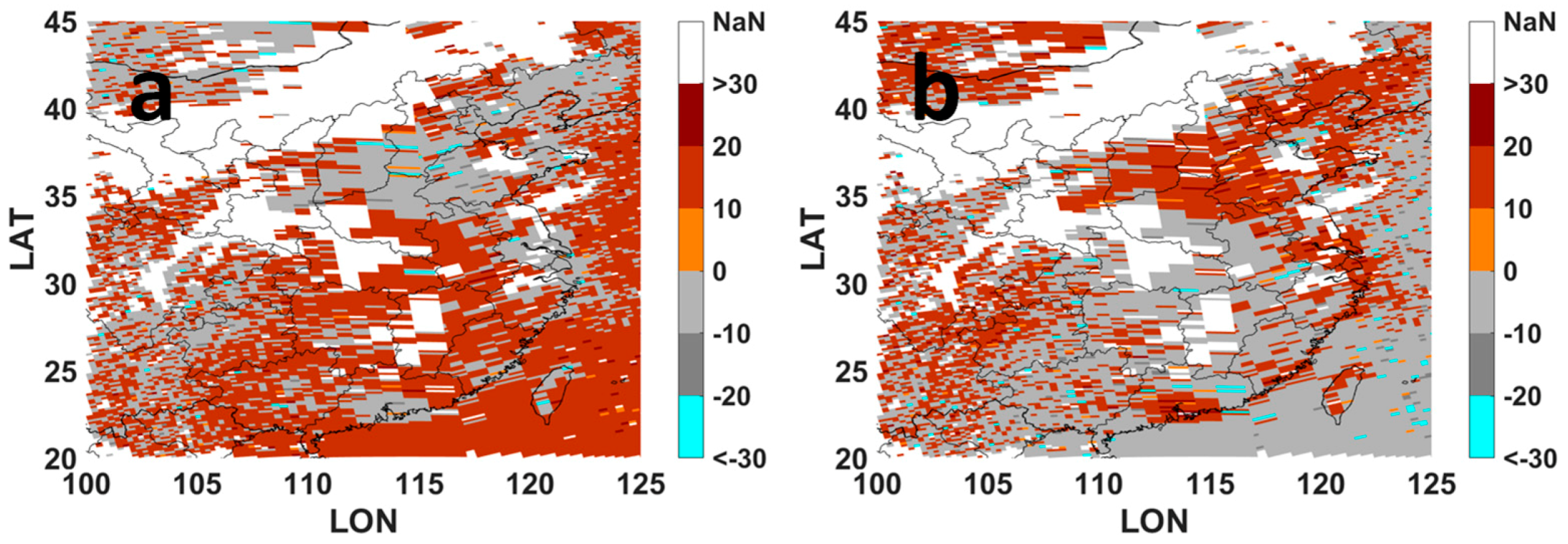
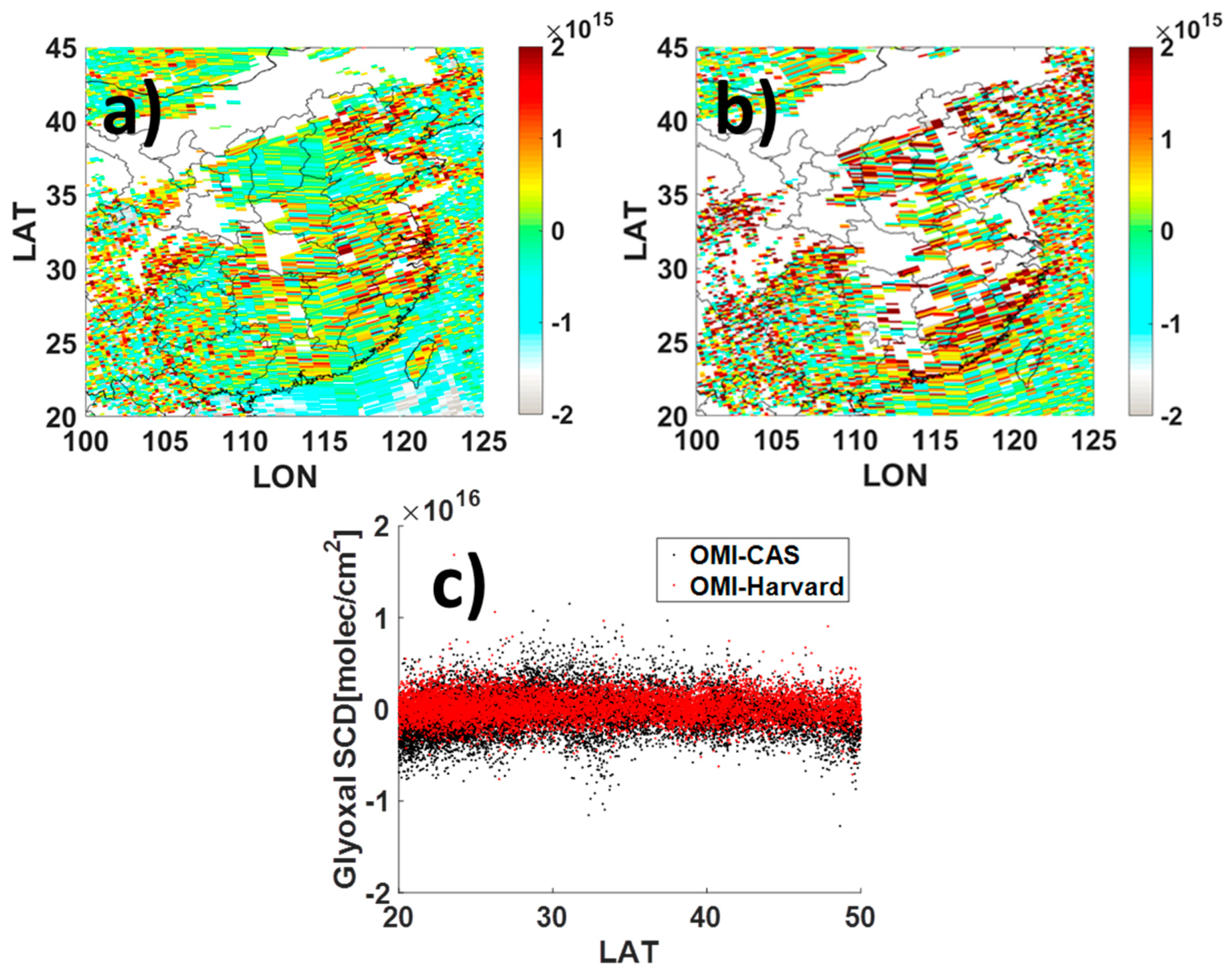
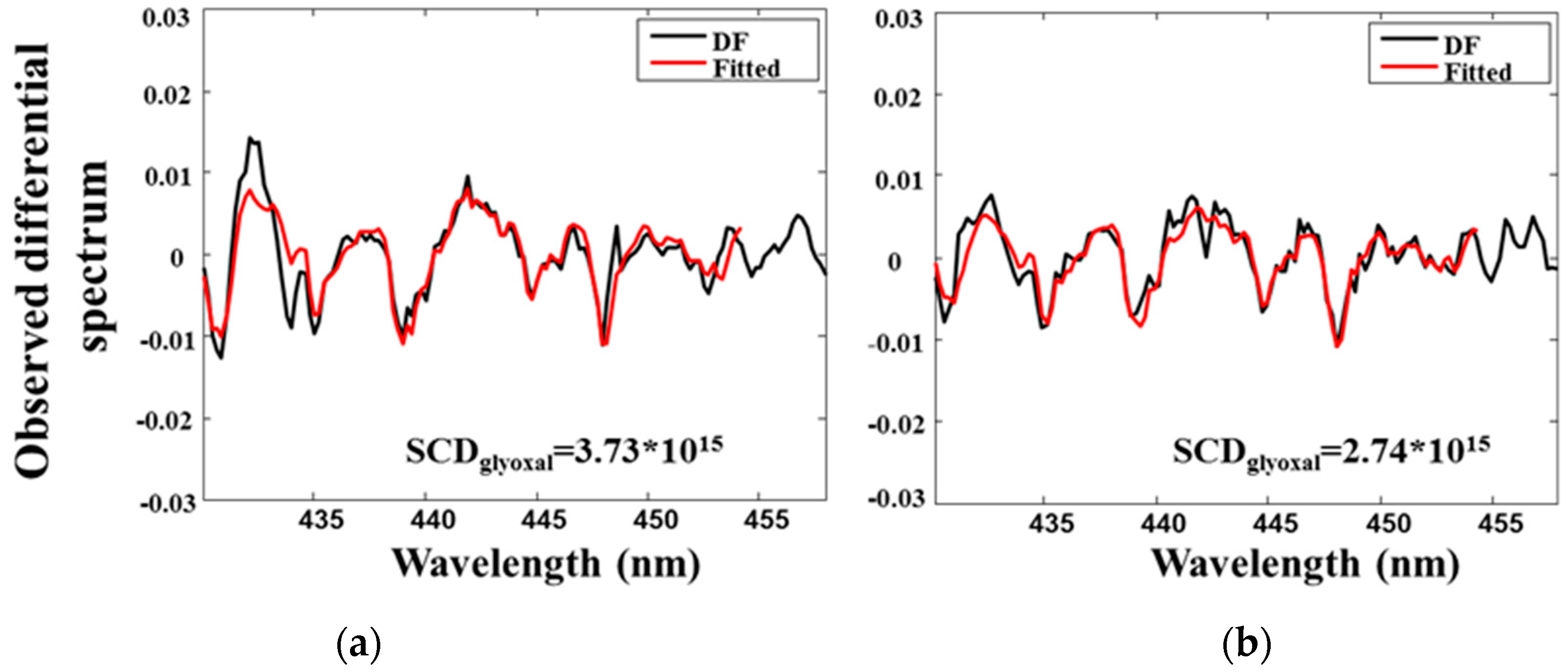

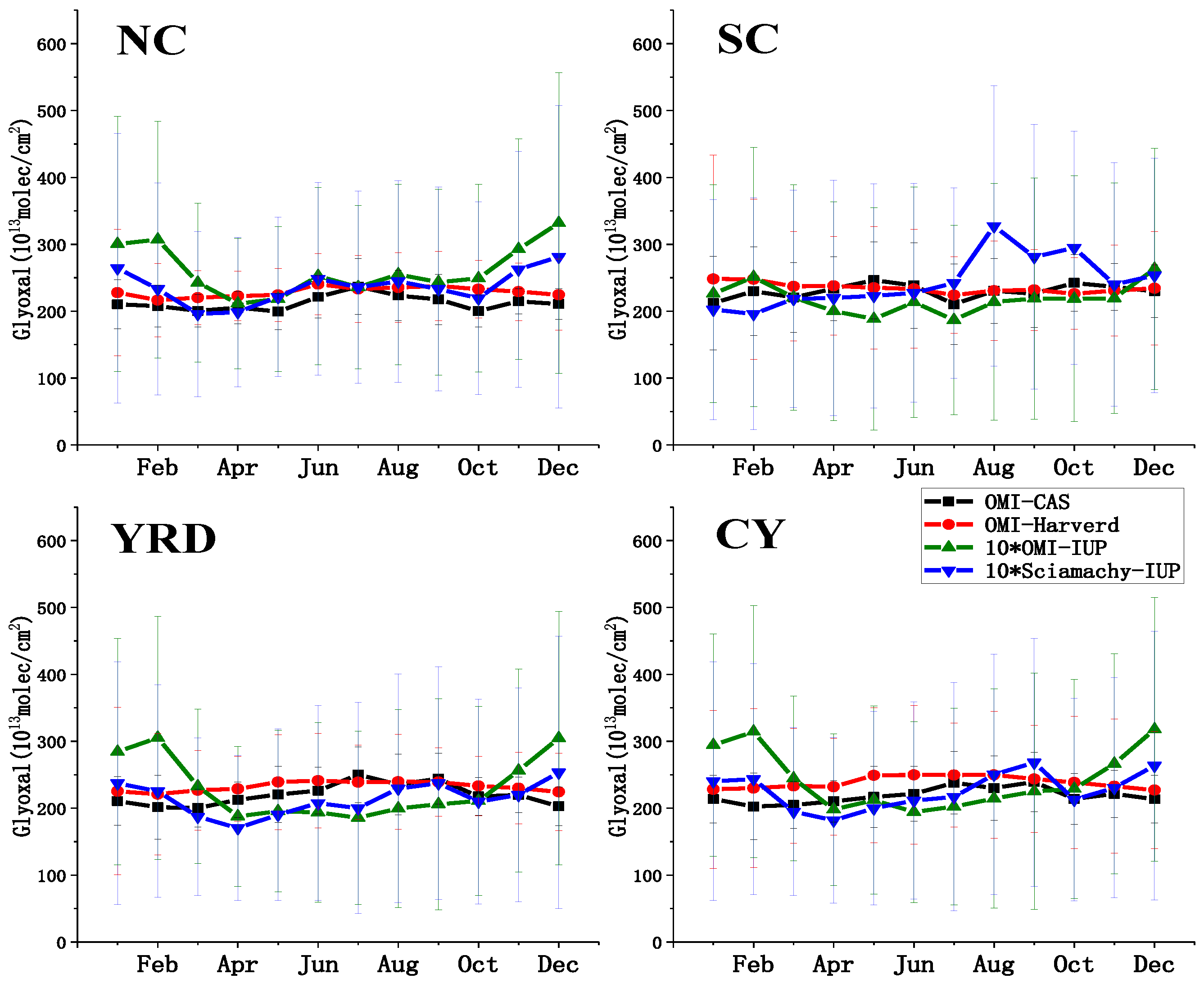
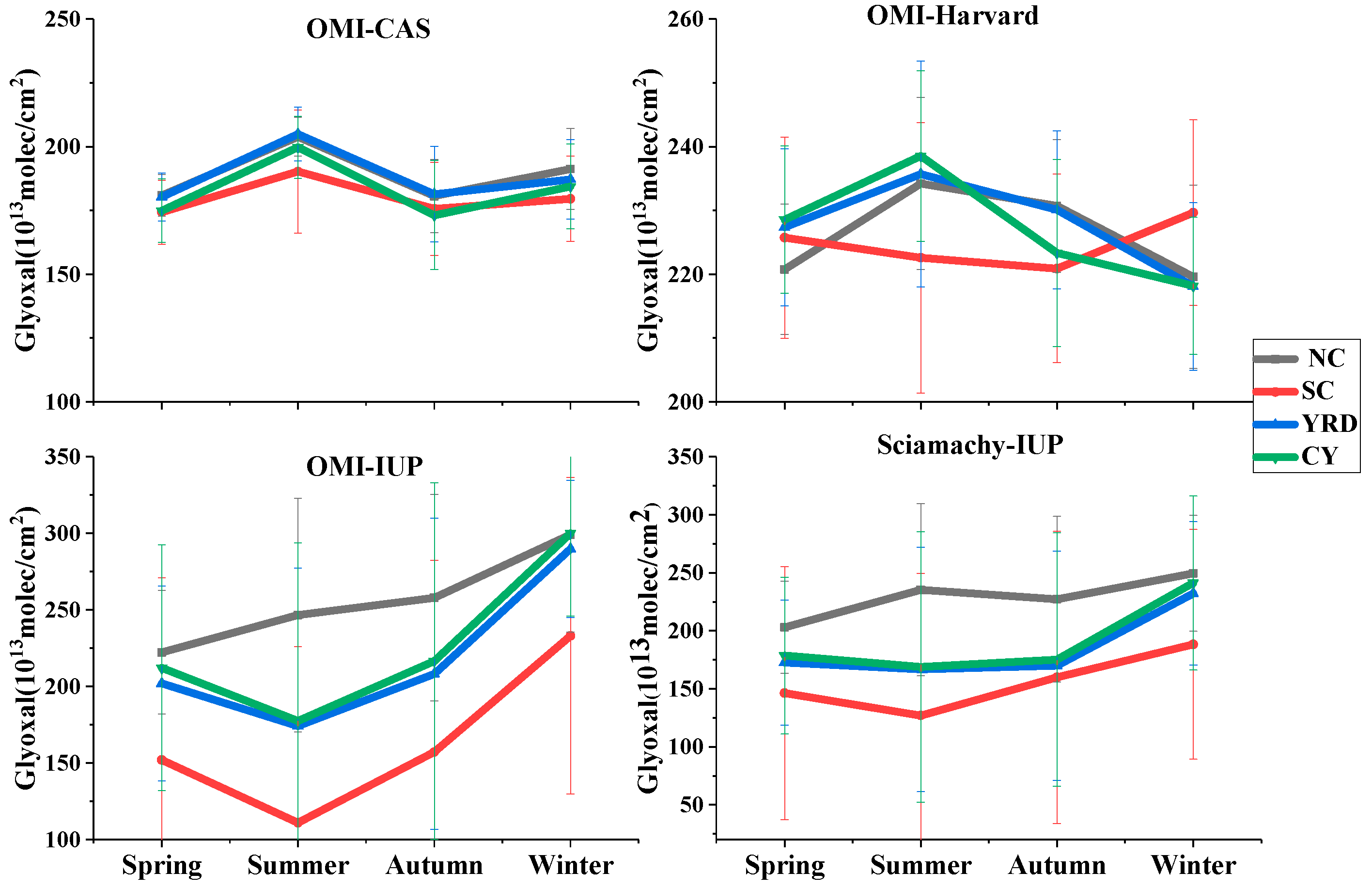

| OMI-CAS | OMI-Harvard | OMI-IUP | Sciamachy-IUP | ||
|---|---|---|---|---|---|
| Fitting window | 430–458 nm | w1: liquid water 385–470 nm | w1: liquid water 410–495 nm | The same as OMI-IUP | |
| w2: glyoxal 435–461 nm | w2: glyoxal 433–458 nm | ||||
| Reference spectrum I0 | Pacific region(daily) | Monthly mean solar irradiance | Pacific region (daily) | ||
| Polynomial | 4th-order | Direct spectrum fitting approach | 3rd-order | 4th-order | |
| Included cross-sections | CHOCHO | √ (296 K) | √ (296 K) | √ (296 K) | √ (296 K) |
| O3 [43] | √ (223 K) | √ (243 K) | √ (223 K) | √ (223 K) | |
| NO2 [44] | √ 1 | √ (220, 294 K) | √ (220, 294 K) | √ (220, 294 K) | |
| O4 | √ (293 K) | √ (293 K) | √ (293 K) | √ (293 K) | |
| H2O | √ (280 K) | √ (280 K) | √ (280 K) | √ (280 K) | |
| H2O (liquid) | × | √ (295 K) | √ (295 K) | × | |
| Ring Effect | calculates by QDOAS Ring tool | uses the Ring spectrum of Chance and Spurr [45] | accounts for both rotational and vibrational Raman scattering [14] | ||
| Cloud Fraction | OMCLDO2 [23] | FRESCO+ [46] | |||
| Destriping correction | × | 5-day mean of the SCD retrieved over the Sahara (20°–30°N, 10°W–30°E) | SCD over selected region (30°N–30°S; 160°E−140°W) | × | |
| Name | Latitude [°] | Longitude [°] | Abbreviation | |
|---|---|---|---|---|
| 1 | North China | [35 40] | [114 121] | NC |
| 2 | South China | [21 26.4] | [105 116] | SC |
| 3 | Yangtze River Delta | [27 35] | [114 121] | YRD |
| 4 | Sichuan and Chongqing region | [27.8 32.9] | [103 110] | CY |
| OMI-CAS | OMI-Harvard | OMI-IUP | Sciamachy-IUP*10 | ||||||
|---|---|---|---|---|---|---|---|---|---|
| Summer | Autumn | Summer | Autumn | Summer | Autumn | Summer | Autumn | ||
| NC | mean | 203.83 | 180.62 | 234.23 | 230.70 | 246.66 | 258.00 | 235.32 | 227.26 |
| std | 7.61 | 14.30 | 13.52 | 10.40 | 76.37 | 67.33 | 74.20 | 71.41 | |
| R | - | - | 0.09 | 0.46 | 0.12 | 0.36 | 0.14 | 0.48 | |
| slope | - | - | 0.05 | 0.62 | 0.01 | 0.08 | 0.02 | 0.11 | |
| intercept | - | - | 192.25 | 36.95 | 199.32 | 154.45 | 197.31 | 149.44 | |
| SC | mean | 190.24 | 175.67 | 222.58 | 220.91 | 111.04 | 157.26 | 126.97 | 159.87 |
| std | 24.23 | 18.26 | 21.20 | 14.78 | 114.94 | 125.03 | 122.68 | 125.82 | |
| R | - | - | 0.79 | 0.63 | 0.80 | 0.46 | 0.74 | 0.56 | |
| slope | - | - | 0.90 | 0.72 | 0.22 | 0.11 | 0.19 | 0.11 | |
| intercept | - | - | −10.744 | 16.89 | 127.40 | 140.34 | 139.28 | 141.71 | |
| YRD | mean | 204.93 | 181.39 | 235.71 | 230.10 | 174.24 | 208.27 | 166.80 | 169.96 |
| std | 10.48 | 18.72 | 17.70 | 12.41 | 103.18 | 101.69 | 105.31 | 98.73 | |
| R | - | - | 0.31 | 0.34 | 0.22 | 0.32 | 0.32 | 0.58 | |
| slope | - | - | 0.18 | 0.52 | 0.03 | 0.09 | 0.05 | 0.14 | |
| intercept | - | - | 161.92 | 61.86 | 194.29 | 148.25 | 186.85 | 135.05 | |
| CY | mean | 199.73 | 173.15 | 238.51 | 223.34 | 177.57 | 216.68 | 168.88 | 175.17 |
| std | 12.10 | 21.35 | 13.38 | 14.70 | 116.28 | 116.48 | 116.45 | 109.09 | |
| R | - | - | 0.35 | 0.62 | 0.42 | 0.29 | 0.49 | 0.52 | |
| slope | - | - | 0.32 | 0.91 | 0.08 | 0.11 | 0.09 | 0.15 | |
| intercept | - | - | 123.53 | −28.93 | 171.84 | 132.85 | 170.27 | 126.60 | |
© 2019 by the authors. Licensee MDPI, Basel, Switzerland. This article is an open access article distributed under the terms and conditions of the Creative Commons Attribution (CC BY) license (http://creativecommons.org/licenses/by/4.0/).
Share and Cite
Wang, Y.; Tao, J.; Cheng, L.; Yu, C.; Wang, Z.; Chen, L. A Retrieval of Glyoxal from OMI over China: Investigation of the Effects of Tropospheric NO2. Remote Sens. 2019, 11, 137. https://doi.org/10.3390/rs11020137
Wang Y, Tao J, Cheng L, Yu C, Wang Z, Chen L. A Retrieval of Glyoxal from OMI over China: Investigation of the Effects of Tropospheric NO2. Remote Sensing. 2019; 11(2):137. https://doi.org/10.3390/rs11020137
Chicago/Turabian StyleWang, Yapeng, Jinhua Tao, Liangxiao Cheng, Chao Yu, Zifeng Wang, and Liangfu Chen. 2019. "A Retrieval of Glyoxal from OMI over China: Investigation of the Effects of Tropospheric NO2" Remote Sensing 11, no. 2: 137. https://doi.org/10.3390/rs11020137




